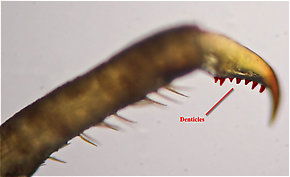Blog & Latest Updates
Fly Fishing Articles
Insects by Common Name


Arthropod Class Insecta (Insects)
Taxonomic Navigation -?-
1 order isn't included.
Common Name
| Match | Common Name |
| Insects |
This is page 80 of specimens of Insecta. Visit the main Insecta page for:
- The behavior and habitat of Insecta.
- 114 underwater pictures of Insecta.
Pictures of 1229 Insect Specimens:
Dixa True Fly Larva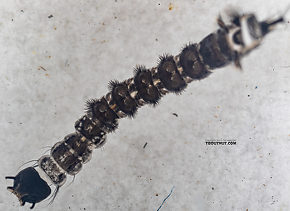 View 10 Pictures
View 10 Pictures
 View 10 Pictures
View 10 PicturesCollected July 25, 2019 from Mystery Creek #249 in Washington
Added to Troutnut.com by Troutnut on July 27, 2019
Added to Troutnut.com by Troutnut on July 27, 2019
Chironomidae (Midges) Midge Adult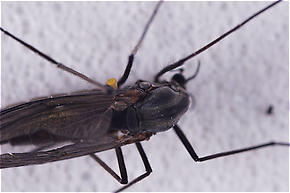 View 3 Pictures
View 3 Pictures
 View 3 Pictures
View 3 PicturesCollected March 29, 2005 from Salmon Creek in New York
Added to Troutnut.com by Troutnut on April 7, 2006
Added to Troutnut.com by Troutnut on April 7, 2006
Dolophilodes (Medium Evening Sedges) Caddisfly Larva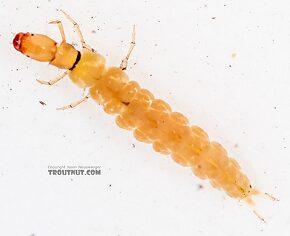 View 9 PicturesI think this larva best fits Dolophilodes, in which the anterior (Anterior: Toward the front of an organism's body. The phrase "anterior to" means "in front of.") margin of the frontoclypeus is supposed to be "slightly asymmetrical." I can't confidently make out the asymmetry, but the other genera are supposed to have either greater asymmetry or a symmetrical, but convex, shape, whereas this one is clearly concave.
View 9 PicturesI think this larva best fits Dolophilodes, in which the anterior (Anterior: Toward the front of an organism's body. The phrase "anterior to" means "in front of.") margin of the frontoclypeus is supposed to be "slightly asymmetrical." I can't confidently make out the asymmetry, but the other genera are supposed to have either greater asymmetry or a symmetrical, but convex, shape, whereas this one is clearly concave.
Based on distribution records, the species should be either aequalis, dorcus, or pallidipes, but I can't find any source to distinguish between them.
 View 9 PicturesI think this larva best fits Dolophilodes, in which the anterior (Anterior: Toward the front of an organism's body. The phrase "anterior to" means "in front of.") margin of the frontoclypeus is supposed to be "slightly asymmetrical." I can't confidently make out the asymmetry, but the other genera are supposed to have either greater asymmetry or a symmetrical, but convex, shape, whereas this one is clearly concave.
View 9 PicturesI think this larva best fits Dolophilodes, in which the anterior (Anterior: Toward the front of an organism's body. The phrase "anterior to" means "in front of.") margin of the frontoclypeus is supposed to be "slightly asymmetrical." I can't confidently make out the asymmetry, but the other genera are supposed to have either greater asymmetry or a symmetrical, but convex, shape, whereas this one is clearly concave. Based on distribution records, the species should be either aequalis, dorcus, or pallidipes, but I can't find any source to distinguish between them.
Collected August 3, 2020 from the East Fork Big Lost River in Idaho
Added to Troutnut.com by Troutnut on August 19, 2020
Added to Troutnut.com by Troutnut on August 19, 2020
Male Callibaetis (Speckled Spinners) Mayfly Spinner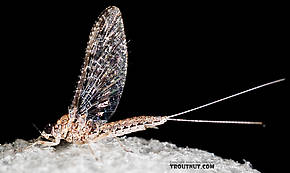 View 4 Pictures
View 4 Pictures
 View 4 Pictures
View 4 PicturesCollected August 11, 2018 from the Henry's Fork of the Snake River in Idaho
Added to Troutnut.com by Troutnut on June 12, 2019
Added to Troutnut.com by Troutnut on June 12, 2019
Kogotus nonus Stonefly Nymph View 9 PicturesAlthough Kogotus and Rickeri nymphs may be difficult or impossible to tell apart, I captured an adult Kogotus nonus specimen in the air on the same day as several of these nymphs, and they are likely the same species.
View 9 PicturesAlthough Kogotus and Rickeri nymphs may be difficult or impossible to tell apart, I captured an adult Kogotus nonus specimen in the air on the same day as several of these nymphs, and they are likely the same species.
 View 9 PicturesAlthough Kogotus and Rickeri nymphs may be difficult or impossible to tell apart, I captured an adult Kogotus nonus specimen in the air on the same day as several of these nymphs, and they are likely the same species.
View 9 PicturesAlthough Kogotus and Rickeri nymphs may be difficult or impossible to tell apart, I captured an adult Kogotus nonus specimen in the air on the same day as several of these nymphs, and they are likely the same species.Collected July 28, 2019 from Mystery Creek #199 in Washington
Added to Troutnut.com by Troutnut on July 30, 2019
Added to Troutnut.com by Troutnut on July 30, 2019
Female Baetidae (Blue-Winged Olives) Mayfly Spinner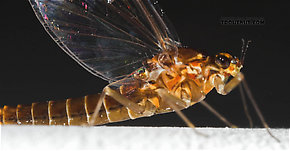 View 8 Pictures
View 8 Pictures
 View 8 Pictures
View 8 PicturesCollected May 26, 2005 from the Namekagon River in Wisconsin
Added to Troutnut.com by Troutnut on May 16, 2006
Added to Troutnut.com by Troutnut on May 16, 2006
Female Ephemerella invaria (Sulphur Dun) Mayfly Dun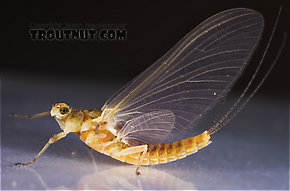 View 6 Pictures
View 6 Pictures
 View 6 Pictures
View 6 PicturesCollected May 28, 2005 from the Teal River in Wisconsin
Added to Troutnut.com by Troutnut on May 24, 2006
Added to Troutnut.com by Troutnut on May 24, 2006
Baetis bicaudatus (BWO) Mayfly Nymph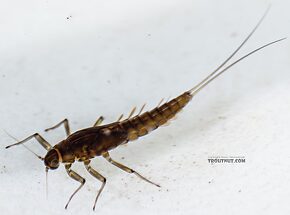 View 5 PicturesHere I'm just copying and pasting, without cleaning up, my notes from spending a long time with this one under the microscope (and keying with Merritt & Cummins 5th Ed) only to end up confirming the most likely guess.
View 5 PicturesHere I'm just copying and pasting, without cleaning up, my notes from spending a long time with this one under the microscope (and keying with Merritt & Cummins 5th Ed) only to end up confirming the most likely guess.
7. Baetis bicaudatus nymph
1. Hind wingpad present but small and hidden beneath forewing pad
2. Segment 2 of labial palp (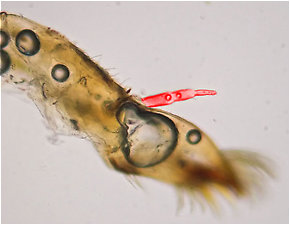 Palp: A long, thin, often segmented appendage which can protrude from certain insect mouth parts such as the maxillae. Also known as the < />palpus.) with well-developed medially projecting corner —> Baetis (couple 44)…. BUT no sign of scale-like setae (Seta: Little hairs on insects.) on abdominal terga (Tergum: the dorsal part of an abdominal segment or segments (terga). Also used to describe the entire abdominal dorsum or the thoracic dorsal segments of Odonata.). Conflicts at this couplet.
Palp: A long, thin, often segmented appendage which can protrude from certain insect mouth parts such as the maxillae. Also known as the < />palpus.) with well-developed medially projecting corner —> Baetis (couple 44)…. BUT no sign of scale-like setae (Seta: Little hairs on insects.) on abdominal terga (Tergum: the dorsal part of an abdominal segment or segments (terga). Also used to describe the entire abdominal dorsum or the thoracic dorsal segments of Odonata.). Conflicts at this couplet.
3. Gills on segments I-VII
4. Tarsal claws (Tarsal claw: The claws at the tip of the tarsus, on an insect's "foot.") with denticles (Denticle: Small tooth-like projects, often appearing like serrations on the tarsal claws of certain mayfly nymphs.), seemingly 2 rows but very hard to tell… and the key options with 2 rows don’t make sense
5. Assuming no villipore, we land confidently at couplet 48
6. Leads to Fallceon, except antennal scape doesn’t have robust setae (Seta: Little hairs on insects.)
7. Treated as Baetis, leads to brunneicolor, but McDunnough et al 1932 (Can Ent 64) suggests middle tail should be 5/6 as long as outer ones
8. Keys VERY confidently to couplet 36 in M&C (villipore)
9. If assuming villipore present:
1. 37 —> Scape of anntenae has no distal (Distal: Far from the point of attachment or origin; near the tip.) lobe —> rules out Labiobaetis (100 % certain)
2. 38 —> Terminal filament much shorter than cerci (Cercus: The left and right "tails" of an insect are known as the cerci or caudal cerci. The middle tail of a three-tailed insect is not.) —> not Barbaetis benfieldi (100 % certain)
3. 39 —> Terminal filament reduced (100 % certain)
4. 40 —> Tarsal claw (Tarsal claw: The claws at the tip of the tarsus, on an insect's "foot.") dentical count couplet. If two rows of denticles (Denticle: Small tooth-like projects, often appearing like serrations on the tarsal claws of certain mayfly nymphs.): Either Iswaeon or Heterocloeon. Can’t be Iswaeon because cerci (Cercus: The left and right "tails" of an insect are known as the cerci or caudal cerci. The middle tail of a three-tailed insect is not.) lack dark median band. Can’t be heterocloeon because it’s not in the Platte drainage or in Texas. Thus, it must be one row of denticles (Denticle: Small tooth-like projects, often appearing like serrations on the tarsal claws of certain mayfly nymphs.). Moving on to 42.
5. 42 —> Hind wing pads (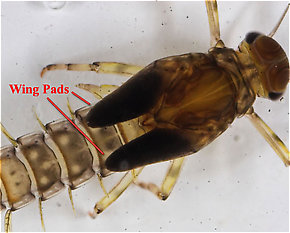 Wing pad: A protrusion from the thorax of an insect nymph which holds the developing wings. Black wing pads usually indicate that the nymph is nearly ready to emerge into an adult.) present (100 % certain)
Wing pad: A protrusion from the thorax of an insect nymph which holds the developing wings. Black wing pads usually indicate that the nymph is nearly ready to emerge into an adult.) present (100 % certain)
6. 44 —> Segment 2 of labial palpi with well-developed medially projecting corner (80 % certain), scale-like setae (Seta: Little hairs on insects.) not evident on terga (Tergum: the dorsal part of an abdominal segment or segments (terga). Also used to describe the entire abdominal dorsum or the thoracic dorsal segments of Odonata.) but maybe limitation of my scope —> Baetis (alternative would be Acentrella, but pronotum (Pronotum: The top of the insect prothorax.) shape is all wrong for those, although not an official characteristic)
7. CONFIDENT in Baetis bicaudatus after distinctive leg markings (J-shaped light mark on first femur (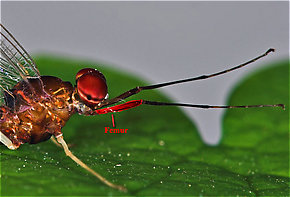 Femur: The main segment of an insect's leg close to the body, in between the tibia and the trochanter.), L-shaped on second and third) matches original species description to a tee.
Femur: The main segment of an insect's leg close to the body, in between the tibia and the trochanter.), L-shaped on second and third) matches original species description to a tee.
 View 5 PicturesHere I'm just copying and pasting, without cleaning up, my notes from spending a long time with this one under the microscope (and keying with Merritt & Cummins 5th Ed) only to end up confirming the most likely guess.
View 5 PicturesHere I'm just copying and pasting, without cleaning up, my notes from spending a long time with this one under the microscope (and keying with Merritt & Cummins 5th Ed) only to end up confirming the most likely guess.7. Baetis bicaudatus nymph
1. Hind wingpad present but small and hidden beneath forewing pad
2. Segment 2 of labial palp (

The palp on the maxilla of an Ephemerella nymph (detached and photographed under a microscope) is highlighted in red here.
3. Gills on segments I-VII
4. Tarsal claws (Tarsal claw: The claws at the tip of the tarsus, on an insect's "foot.") with denticles (Denticle: Small tooth-like projects, often appearing like serrations on the tarsal claws of certain mayfly nymphs.), seemingly 2 rows but very hard to tell… and the key options with 2 rows don’t make sense
5. Assuming no villipore, we land confidently at couplet 48
6. Leads to Fallceon, except antennal scape doesn’t have robust setae (Seta: Little hairs on insects.)
7. Treated as Baetis, leads to brunneicolor, but McDunnough et al 1932 (Can Ent 64) suggests middle tail should be 5/6 as long as outer ones
8. Keys VERY confidently to couplet 36 in M&C (villipore)
9. If assuming villipore present:
1. 37 —> Scape of anntenae has no distal (Distal: Far from the point of attachment or origin; near the tip.) lobe —> rules out Labiobaetis (100 % certain)
2. 38 —> Terminal filament much shorter than cerci (Cercus: The left and right "tails" of an insect are known as the cerci or caudal cerci. The middle tail of a three-tailed insect is not.) —> not Barbaetis benfieldi (100 % certain)
3. 39 —> Terminal filament reduced (100 % certain)
4. 40 —> Tarsal claw (Tarsal claw: The claws at the tip of the tarsus, on an insect's "foot.") dentical count couplet. If two rows of denticles (Denticle: Small tooth-like projects, often appearing like serrations on the tarsal claws of certain mayfly nymphs.): Either Iswaeon or Heterocloeon. Can’t be Iswaeon because cerci (Cercus: The left and right "tails" of an insect are known as the cerci or caudal cerci. The middle tail of a three-tailed insect is not.) lack dark median band. Can’t be heterocloeon because it’s not in the Platte drainage or in Texas. Thus, it must be one row of denticles (Denticle: Small tooth-like projects, often appearing like serrations on the tarsal claws of certain mayfly nymphs.). Moving on to 42.
5. 42 —> Hind wing pads (

The wing pads on this final instar Baetidae mayfly nymph are extremely dark.
6. 44 —> Segment 2 of labial palpi with well-developed medially projecting corner (80 % certain), scale-like setae (Seta: Little hairs on insects.) not evident on terga (Tergum: the dorsal part of an abdominal segment or segments (terga). Also used to describe the entire abdominal dorsum or the thoracic dorsal segments of Odonata.) but maybe limitation of my scope —> Baetis (alternative would be Acentrella, but pronotum (Pronotum: The top of the insect prothorax.) shape is all wrong for those, although not an official characteristic)
7. CONFIDENT in Baetis bicaudatus after distinctive leg markings (J-shaped light mark on first femur (

The femur of this Isonychia bicolor mayfly spinner is highlighted in red.
Collected August 4, 2020 from Green Lake Outlet in Idaho
Added to Troutnut.com by Troutnut on August 20, 2020
Added to Troutnut.com by Troutnut on August 20, 2020
Male Glossosoma alascense Saddle-case Maker Adult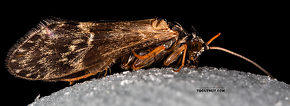 View 8 PicturesI lost track of this specimen before I could get it under my microscope, but caddis expert Dave Ruiter was able to identify it from pictures as Glossosoma, with an uncertain suggestion of G. alascense as the most likely species.
View 8 PicturesI lost track of this specimen before I could get it under my microscope, but caddis expert Dave Ruiter was able to identify it from pictures as Glossosoma, with an uncertain suggestion of G. alascense as the most likely species.
 View 8 PicturesI lost track of this specimen before I could get it under my microscope, but caddis expert Dave Ruiter was able to identify it from pictures as Glossosoma, with an uncertain suggestion of G. alascense as the most likely species.
View 8 PicturesI lost track of this specimen before I could get it under my microscope, but caddis expert Dave Ruiter was able to identify it from pictures as Glossosoma, with an uncertain suggestion of G. alascense as the most likely species.Male Ephemerella aurivillii Mayfly Dun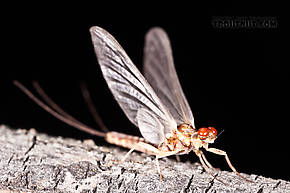 View 9 PicturesThis dun hatched in my aquarium on July 16th from an easily identified nymph collected on July 10th, and it molted into a spinner after I photographed it. The beautiful spinner form is listed as separate specimen. I forgot to photograph the dun with the ruler, but naturally his size is pretty similar to what it was as a spinner.
View 9 PicturesThis dun hatched in my aquarium on July 16th from an easily identified nymph collected on July 10th, and it molted into a spinner after I photographed it. The beautiful spinner form is listed as separate specimen. I forgot to photograph the dun with the ruler, but naturally his size is pretty similar to what it was as a spinner.
 View 9 PicturesThis dun hatched in my aquarium on July 16th from an easily identified nymph collected on July 10th, and it molted into a spinner after I photographed it. The beautiful spinner form is listed as separate specimen. I forgot to photograph the dun with the ruler, but naturally his size is pretty similar to what it was as a spinner.
View 9 PicturesThis dun hatched in my aquarium on July 16th from an easily identified nymph collected on July 10th, and it molted into a spinner after I photographed it. The beautiful spinner form is listed as separate specimen. I forgot to photograph the dun with the ruler, but naturally his size is pretty similar to what it was as a spinner.Top 10 Fly Hatches
Top Gift Shop Designs
Eat mayflies.
Top Insect Specimens
Miscellaneous Sites
Troutnut.com is copyright © 2004-2024 Jason
Neuswanger (email Jason). See my FAQ for information about use of my images.
 privacy policy
privacy policy

